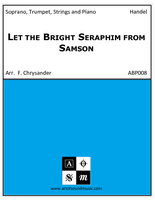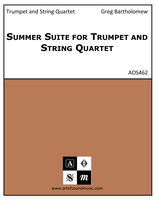Trumpet and the “Rule of Three” – Complete Method
| Composer | O'Hara, Chris |
|---|---|
| Duration | 120 |
| Ensemble | Trumpet |
| Genre | Method Book |
| Grade | 4 |
| Model Number | AOS1829 |
| Category | 2 Trumpets, Method Books, Solo Trumpet |
THREE RULES
- Always Play with Your Best SOUND
- Always have the AIR to support your SOUND
- Always Serve the MUSIC
Available as a PDF download or hard copy or both. The printed version of this book is coil-bound for durability and lays perfectly flat on your music stand.
From the author….
Trumpet playing, in general, is a very easy and fun activity. That is not to say that it does not have its share of challenges. I have never been a "naturally talented" player, and as a result have had to work fairly hard for my successes. Over the course of my career, I have come upon a method to approach trumpet playing that has been very useful and successful for myself, and my students.
I always find that the best way to approach most things is often the simplest. To that end, I have developed the Rule of Three. Throughout this method, you will see things grouped in threes and, and many concepts will be laid out in threes. Three is a very powerful number and has been used in countless examples, such as “Life, Liberty, and the Pursuit of Happiness”- American Declaration of Independence, “Veni, Vidi, Vici” (“I came, I saw, I conquered”) – Julius Caesar,
or the more applicable “Faster, Higher, Louder” – Trumpet Player’s Motto.
This method is divided into Three main sections that I use in my teaching:
1. Buzzing: All sound on any brass instrument begins as a buzz, and our mouthpieces are our primary instruments. The (admittedly simplified) relationship between mouthpiece and trumpet is similar to that of an electric guitar and amplifier. An electric guitar without an amp is still able to play and play all of the same notes and songs. Although the sound is softer and slightly tinny, every other aspect is the same. Once the guitar is mastered, you plug into the amp and you get the sound that you want. The same is true of the mouthpiece. Without the trumpet, the sound is softer and not the polished sound we aspire to, but we are still able to play the same music. The better and clearer that we are able to play on the mouthpiece, the better and more accurate our trumpet playing will become. Just as with the electric guitar, if we aren't good on our mouthpiece, plugging into our amp, the trumpet, will not make our playing better.
2. Scales: All music is made up of scales. Whether you want to play classical music, jazz, rock, or anything else, a thorough understanding of scales will make your performance better and easier! This method provides several exercises designed to aid in the mastery of the common Major and minor scales as well as Modes, Chromatics, and several other scale variants and patterns. This section also contains several musical examples in each key to put your scale knowledge to the test.
3. Music: Once you have a solid grasp of the fundamentals of trumpet playing through buzzing, ear-training (interval work), and scale work, we will then apply those skills to music. This method contains some of my favorite solos, etudes, and excerpts as well as exercises taken from famous musical works designed to aid in furthering your skill sets through the exploration of music. As you begin your exploration of this method, I wish you great success and joy playing the
trumpet!
Reviews of “TRUMPET and the ‘Rule of Three’ – Complete Method”
Dr. Bruce Briney, Trumpet Professor, Western Illinois University (retired)
Chris O’Hara’s Trumpet and the Rule of Three represents a major project on the grand scale of the Arban and St. Jacome tutors that we’ve embraced for centuries. The book is divided into three sections: buzzing/fundamentals, scales and music. The introduction includes commentary on the author’s three driving concepts; playing with the best sound, efficiently using wind, and cultivating the expressive qualities of musicianship. The reader will find a thorough pedagogical text devoted to the developing player. Exercises can be easily incorporated into a daily routine including harmonic slurs, articulation drills and scales with practical applications to important orchestral and solo excerpts. The final music section includes samplings of unaccompanied Bach, blues etudes and a comprehensive approach to preparing three of our most popular Arban Characteristic Studies.
What makes the method unique is not only it’s compendium of scales and the wide variety of musical styles, but most importantly, Dr. Ohara’s pedagogical and philosophical approach to teaching the trumpet. Trumpet and the Rule of Three has something for everyone, from the young, aspiring player to the
experienced teacher.
Steven Trinkle, Trumpet, Houston Symphony, the August Symphony, the Kansas City Philharmonic, the Shreveport Symphony, the Orchestra Sinfonica dalla Radiotelevisione Italiana and the Orquesta Sinfonica de Maracaibo
This book is very thorough with clear and concise explanations of the principles of the “Rule of Three” with detailed visuals to support the text. There are many examples demonstrating each topic being examined making it possible to explore the book from different levels of ability thereby making the book usable from younger students through very advanced students.
The explanations are simple and direct giving the text a clarity that is much appreciated. By beginning with more simple examples and continuing through more difficult examples, students are able to measure their progress and see their ultimate goals.
The Guide to Practice is especially helpful. These examples demonstrate a clear process of study allowing a student to master difficult passages and achieve security in performance. This then becomes a process which may be repeated again and again. I believe “Trumpet and the Rule of Three” is a significant contribution to the pedagogical materials available to trumpet students and trumpet teachers today.
Dr. Kayla Solomon, Trumpet Performer, Teacher
Trumpet and the Rule of Three fills in the fundamental gaps for both trumpet players and educators. In this
book, Christopher O’Hara presents a detailed explanation of how to get the most out of his book. Both beginners as well as experienced trumpet players can learn a lot about the basics of music and practicing techniques outlined in the introduction.
The progression of drills and exercises in the buzzing/fundamental section guides the player or teacher through the process of developing a strong foundation in trumpet technique. O’Hara addresses issues that are not typically outlined in trumpet method books, such as providing descriptions of how to establish a steady sound on the instrument.
Overall, this method book assists students with much more than the standard drills and exercises to develop strong fundamental technique on the trumpet. Through this book, O’Hara has brought the teacher into the practice room. A student using this book can utilize the methods and apply them to their own practice sessions. This book offers students all the necessary material needed to advance as a trumpet player, all they need to do is apply them to their practice.
Rex Richardson
International Soloist Associate
Professor of Trumpet University of South Carolina
A comprehensive and rigorous recasting of trumpet fundamentals. Chris O'Hara offers solid technical advice in clear, succinct text to support this compilation of eminently pragmatic exercises. This book will set your chops up properly every day!








